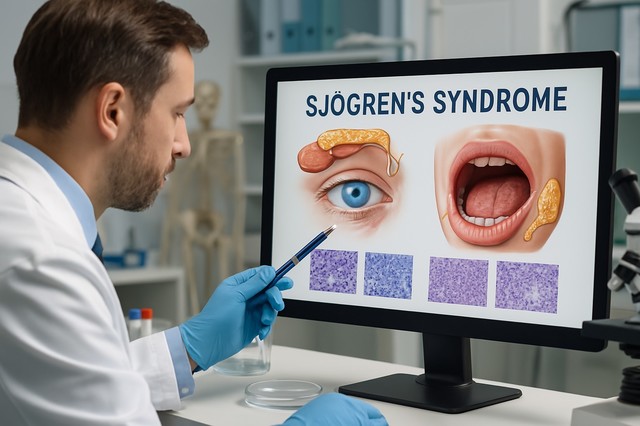Hope for Dry Eyes and Mouth: Breakthrough in Sjögren’s Syndrome Treatment
Published:
Unlocking the Mystery of Gland Damage
Millions of Americans, particularly women, grapple wiht Sjögren’s syndrome, a debilitating autoimmune disorder marked by relentless dry mouth and eyes. These symptoms aren’t just uncomfortable; thay can severely disrupt daily life, impacting everything from eating and speaking to sleeping and working. But on April 7, 2025, a ray of hope emerged from a new study that pinpoints a key underlying cause of the gland damage in Sjögren’s syndrome and suggests novel therapeutic avenues.
The chronic autoimmune condition, known for it’s hallmark symptom of hyposacreation, characterized by an abnormal reduction in saliva and tears, can have far-reaching consequences for oral, eye, and overall health. Now, researchers have identified crucial mechanisms driving the dysfunction of exocrine glands, offering a fresh outlook on treatment strategies.
For years, the precise mechanisms by which Sjögren’s inhibits tear and saliva production remained elusive. The new research, recently published in the International Journal of Oral Science, reveals that in the early stages of the disease, a protein called tricelulin undergoes degradation. Tricelulin acts as a crucial cellular glue, maintaining cohesion within the salivary and tear glands. When this protein breaks down,the structural integrity of these glands is compromised,leading to a decline in thier secretory efficiency.
Two Promising Therapies Show Regenerative Potential
The study didn’t stop at identifying the root cause; it also explored potential therapeutic interventions.Excitingly, researchers tested two experimental therapies on animal models, both demonstrating the ability to restore normal gland function.
One approach involved an experimental drug, AT1001, which showed promise in regenerating already-damaged cellular structures. The other utilized a preclinically tested molecule to prevent the degradation of these structures in the frist place.
According to researchers, both therapies successfully restored normal gland function in the animal models, suggesting a promising framework for developing therapeutic strategies applicable to patients.
Shifting the Treatment Paradigm
The implications of this research are significant, perhaps revolutionizing how Sjögren’s syndrome is treated.
this discovery fundamentally changes the approach to the treatment of Sjögren syndrome.Dr. Xin Cong, Peking University
This insight suggests a move away from simply managing inflammation to actively repairing the structural damage within the glands.
We go to solutions that do more than to reduce inflammation and now focus on the effective repair of structural lesions at the level of the glands. And more encouraging is that both approaches work, which gives us real confidence in the advancement of applicable therapies.Dr.Xin Cong,Peking university
This novel approach offers hope for more effective and long-lasting relief for those suffering from the debilitating symptoms of Sjögren’s syndrome.
Sjögren’s Syndrome in the U.S.: A Closer Look
Sjögren’s syndrome affects an estimated 4 million Americans, with women nine times more likely to be diagnosed than men, according to the Sjögren’s Foundation. The average age of diagnosis is late 40s, but the disease can occur at any age.
Beyond dry mouth and eyes, Sjögren’s can cause a range of other symptoms, including fatigue, joint pain, and nerve damage. It can also increase the risk of certain complications, such as lymphoma.
Many Americans find everyday tasks significantly impacted. Such as, something as simple as enjoying a meal can become a challenge due to difficulty swallowing dry food. Speaking for extended periods can be painful, impacting professional and social interactions.
| Symptom | impact on Daily Life |
|---|---|
| Dry Mouth | Difficulty eating, speaking, increased risk of dental problems. |
| dry Eyes | Blurred vision, sensitivity to light, gritty sensation, increased risk of eye infections. |
| Fatigue | Reduced energy levels, difficulty concentrating, impacts work and social life. |
| Joint Pain | Limited mobility, difficulty performing everyday tasks, reduced quality of life. |
Addressing Potential Counterarguments
While these findings are promising, it’s significant to acknowledge the limitations of the study. The research was conducted on animal models,and further studies are needed to confirm these results in human clinical trials. Additionally,the long-term effects of these therapies are still unknown.
Some might argue that focusing on structural repair is less crucial than managing the underlying autoimmune response that triggers Sjögren’s. However, this new research suggests that addressing the gland damage directly may provide more effective and lasting relief, especially in the early stages of the disease.
Looking ahead: Practical Applications and Future Research
The findings from this study offer a clear direction for future research and drug development. Clinical trials are needed to evaluate the safety and efficacy of AT1001 and other similar therapies in humans. Further research is also warranted to explore the role of tricelulin in the pathogenesis of Sjögren’s and to identify other potential therapeutic targets.
For Americans living with Sjögren’s syndrome,this research provides a renewed sense of hope.While these therapies are still in the experimental stage, they represent a significant step forward in the quest for more effective treatments that can improve the quality of life for millions.








